Iris Erez is on the outside, looking in. Invited by Yasmeen Godder, with whom she worked as a dancer for several years, to create a new work for the Curtain Up Festival which will premiere in a joint evening on Friday, November 27, she has choreographed Numbia, a trio performed by Asaf Aharonson, Lee Meir and Maya Weinberg. Having performed in most of her works – Protection Formula (2003), Temporary (2007) and Manual (2009), currently performing as Lady Macbeth at the Tmuna Theatre in Tel Aviv, and having recently returned from China and Japan, where she performed in Solo Colores which was created for her by Arkadi Zaides, Erez is now working from a very different vantage point.
Erez rode up on her bike between rehearsals to talk about Numbia, space, time, pleasure and pain with Ayelet Dekel of Midnight East.
Ayelet Dekel: The name Numbia intrigues me I have my associations from English, but I want to confirm it with you…
Iris Erez: Absolutely. Numb. The name comes from the word, feeling.
We thought…there were so many names, we considered “Numby.”
The work deals with the lack of feeling and the desire, the need to feel something in a world that lacks feeling. It’s a little like Narnia – it’s not real, but it is very realistic. Reminiscent of a dream, in terms of the lighting we use, and the feeling. It’s a kind of hallucination, yet in the same breath it’s reality. For those people it is their reality…our reality in the studio.
AD: You use the pronoun “we” a great deal, do you view the dancers as participants in the creative process?
IE: Very much so, the dancers were very much a part of the creative process from the beginning. There were some changes, it was supposed to be a quartet, and it became a trio. I wanted to work with a group. A group of people who experience undergo an experience…a trio is not quite a group. But the communication between them was very strong from the beginning. They exist as themselves and I understood that I could not add another dancer to this group.
AD: Have they worked together before?
IE: No. They come from different dance backgrounds. Asaf is very young. He is in the Vertigo dance workshop, Lee Meir is from Klipa, Maya worked with Yasmeen and is also an independent choreographer, and they are all engaged in creating dance. They were so devoted, so entirely within the work; they bring so much of themselves into it. It’s us.
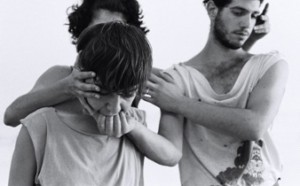
AD: Based on what I’ve seen of your work, I feel that you are involved with processes taking place somewhere very deep within the body that have an external expression that marks something internal. From seeing a rehearsal of Numbia, I feel that something opened up in terms of scale that enables different things that cannot be seen in a solo or duet. They may exist, but cannot be seen – the composition, the way you relate to the space.
IE: I felt that I suddenly had a different relationship to the space and also time. The time in this work is not characteristic of me. There are always so many things happening at once [referring to Temporary] and it’s all very intense. Here I felt that there was more time for things to happen. The work opened up so many possibilities relating to sensation and pain; so many worlds that we felt it could fill an evening. It was originally longer, we made it shorter – it is now 20 minutes.
It relates to a project in Italy, I was invited to Operastate (2007) to create a dance at the museum in Possagno in honor of 250 years to the neo-classical sculptor Antonio Canova (1757-1822). He made sculptures of limestone that were marked with nails so that they could be replicated. I saw photographs of these works and when I saw the place itself I thought of sculptures – the heroic body, the classic body and its mythological image. The ideal of beauty, with ideal proportions, yet within there is also something flawed. Some of the sculptures were destroyed in WWII so that there were also sculptures on display that were amputated, with severed limbs. I was surrounded by images of something at once beautiful and damaged, flawed, and in the flaw there is also something beautiful.
Within this ideal there is a flaw that transforms it into something emotionally moving.
In that frame of mind I thought of dance and the dancer’s body that works very hard to create something beautiful. Modern dancers – they don’t have the ideal body, it’s not classical dance, but there is something that is presented on the stage and you can’t see how much work it involves, the injuries and the pain that takes place behind the scenes. From the beauty I wanted to engage with the pain and the injury. It’s an inseparable part of a dancer’s life. Pain as a human experience is a part of all our lives.
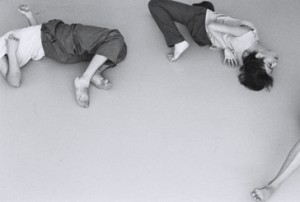
In Possagno I created a site specific work for 8 dancers, there was a different kind of relationship to the space, and it was not a stage performance. The audience followed the dancers through the museum. It also related to the body in spatial terms, understanding the spaces within the body. Actually, what I did there engaged with the body and its history of injuries. Two Italian women created the music, so it was all women, so there was also something very emotionally affecting about that aspect of the work.
After creating this piece, I taught a work of Yasmeen’s in London and I was injured. It was a strange coincidence. I couldn’t dance for half a year. 2008 was a year of recovery, psychological recovery to return to my body without fear.
AD: In Numbia, there is also text, spoken by Asaf – is it improvised?
IE: Asaf improvises at the end – each time we tried decide how many stories there should be, to set a fixed text, it didn’t work. He really needs to remember, its part of our history as people. We have our scars and each scar has a story. Sometimes he invents things. It’s confabulation – we invent explanations to fill the gaps in our memory so that our lives will make sense to us. The body heals itself; perhaps you invent something to explain it.
I was also interested in the distinction between truth and lie? Assaf didn’t want to talk at first, he felt uncomfortable. At some point in the process, suddenly it didn’t stop; he didn’t want to stop talking.
For me it all connected to the relativity of pain and the world of dance. There is a certain tolerance for pain and endurance, their threshold for pain is higher. They go onstage and insane things. In this work I was interested in the ability to represent pain and to remember pain. I read an interesting essay by Michal Ben Naftali, which deals with this and the difficulty of understanding another person’s pain.
AD: Stanley Cavell writes about the ability to understand another person’s pain through their representation of that pain.
IE: At some point in the dance, Asaf is saying “Maya” and it turns into “aya” [a cry of pain].
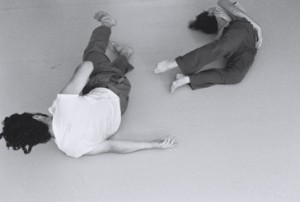
AD: There is the sensation, the memory, the endurance, the respresentation of that pain, and perhaps also the element of pleasure?
IE: When does pain become pain and cease being pleasurable? If you seek a sensation, what are the limits of that sensation? Where is the limit? When is it both together, pleasure and pain? There is something very addictive to dancers in that physical need to dance. I think dancers (of course this is a generalization) have a tendency to hyposensitivity – that they have a need for a very extreme physical experience in order to feel themselves, to feel something.
There is a paradox – on one hand they are very aware of their bodies and take care of their bodies. There is the dance technique of release, which I use, and Yasmeen uses, which is very good for the body. But for example, rehearsals – it doesn’t make sense to repeat one movement infinite times in rehearsal.
I connect this to the world of sensations in general – people have become numb. You need a serious stimulation to attract your attention, otherwise things pass you by. You need very powerful things to move you. As someone who is concerned with bringing an audience, you need to do a lot to get someone to leave the house. People have everything at home. Everything is available.
AD: Except the outdoors.
IE: Even the outdoors, at its virtual level, is available in your home. You can travel the world through your computer, it’s amazing. – but you can’t touch it. Maybe someday we will be able to touch through skype.
AD: This is where we touch upon your work – because it is involved with the sensation of touch.
IE: To feel something, even if it hurts, even if it is unpleasant. To know that someone has touched you; to experience your own existence through touch. Lee marks on her body the places the other dancers touch her. Each person has his or her own threshold – as an observer too (not just participant).
Erez comes full circle in her thoughts, reflecting on the current process in which she is creating a dance in which she does not perform.
IE: When I was outside… you quickly forget how hard it is [for the dancers]. It’s very strong – from my perspective I wanted them to do it over and over again. It’s good to be outside, to experience the work from outside. For me there is something that is right about the separation, but I am not giving up my place as a dancer. I feel a lot of pressure building up towards the premiere and [because I am not dancing] I don’t have any way to release it.
Performances:
5.12 at 21:00
Suzanne Dellal Centre, Tel Aviv, 03-5105656, www.suzannedellal.org.il
14.12 at 20:00
Rebecca Crown, Jerusalem Theatre, 02- 5605755, www.jerusalem-theatre.co.il
Image credit: Itay Marom

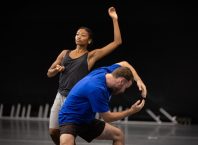
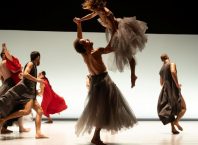


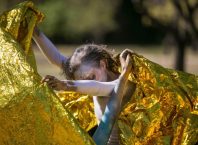
Comments are closed.